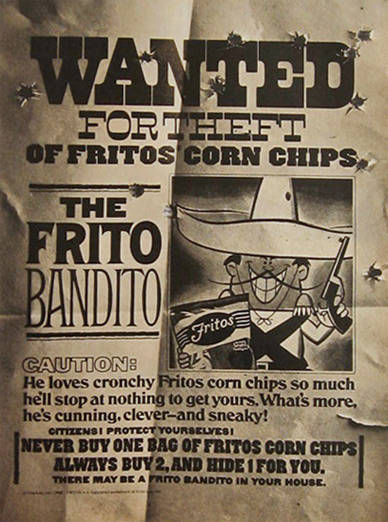When I was young, I loved to sing the jingle to the Frito corn chip commercial as loud as I could: Ay Yi Yi Yi! Oh, I am the Frito Bandito.
I also coveted my Frito bandito pencil top eraser I got in a trade at school.

Oh, if I only knew then what I know now: The cartoon mascot who spoke broken English and robbed people of their chips at gunpoint is one of the most egregious examples of stereotypes used by American businesses to promote sales.
I had long forgotten the bandito character until recently when I found three red pencil toppers in a box of junk. Seeing them brought back a flood of memories but also piqued my curiosity.
Whatever happened to the bandit?
Thanks to the internet, I found out.
I was only four years old when the Frito Corporation (founded in 1932 in San Antonio) began marketing the Frito corn chip. The bandito mascot began appearing in television commercials during children’s programs in 1967.
The bandito was created by Foote, Cone and Belding Agency; animated by Tex Avery; and given a voice by Mel Blanc, who also did Bugs Bunny, Daffy Duck and other cartoon characters. The mascot was modeled after the “Mexican bandit” stereotype portrayed in Western movies.
He wore a sombrero, had a handlebar mustache, spoke with a thick accent and carried two pistols he used to rob people. The bandit also sang his jingle to the tune of the traditional Mexican song “Cielito Lindo.”

Although the first words of the song are pronounced the same, the spelling is different: Aye, Yai, Yai, Yai or Ay,ay,ay – but misspelled Ay Yi Yi Yi in the commercial version.
The Frito Corporation wasn’t the only business to exploit the Mexican revolutionary stereotype: Liggert & Myers Tabacco Company, Elgin Watch Company and American Motors are among that list.
The Frito Bandito campaign drew the attention of the National Mexican-American Anti-Defamation Committee in Washington D.C. and the San Antonio-based Involvement of Mexican-Americans in Gainful Endeavors.
Under pressure from these two groups, the Frito Corporation updated the bandit by eliminating his gold tooth and facial stubble and combed his hair. Corporation officials stood by the character claiming a survey in four California and Texas cities found that 85% of Mexican-Americans liked the bandito.
Apparently, Tyler was not one of the cities included in the survey, although quite likely, there are residents who still remember buying a bag of Fritos and finding the bandito prize inside. I wonder how the Hispanic community in Tyler – now at 21.6% of the population – would react to such a campaign today.
The corporation also took away the bandit’s pistols in 1968 after the assassination of Robert F. Kennedy.
The organizations shifted their protests to television stations that aired the Frito commercials, and in 1969 KPIX, KRON in San Francisco, and KNBC in Los Angeles. These three stations were the first to ban the Frito commercial.

That same year, the Frito corporation introduced a new character, W.C. Fritos, after the famous comedian W.C. Fields. W.C. Fritos addressed viewers with the popular phrase, “Greetings, my little chip-a-dees.”
The bandito campaign ended in 1971 but made its mark in history as one of the first successful challenges against the use of Mexican stereotypes in advertising.
Love what you're seeing in our posts? Help power our local, nonprofit journalism platform — from in-depth reads, to freelance training, to COVID Stories videos, to intimate portraits of East Texans through storytelling.
Our readers have told us they want to better understand this place we all call home, from Tyler's north-south divide to our city's changing demographics. What systemic issues need attention? What are are greatest concerns and hopes? What matters most to Tylerites and East Texans?
Help us create more informed, more connected, more engaged Tyler. Help us continue providing no paywall, free access posts. Become a member today. Your $15/month contribution drives our work.







